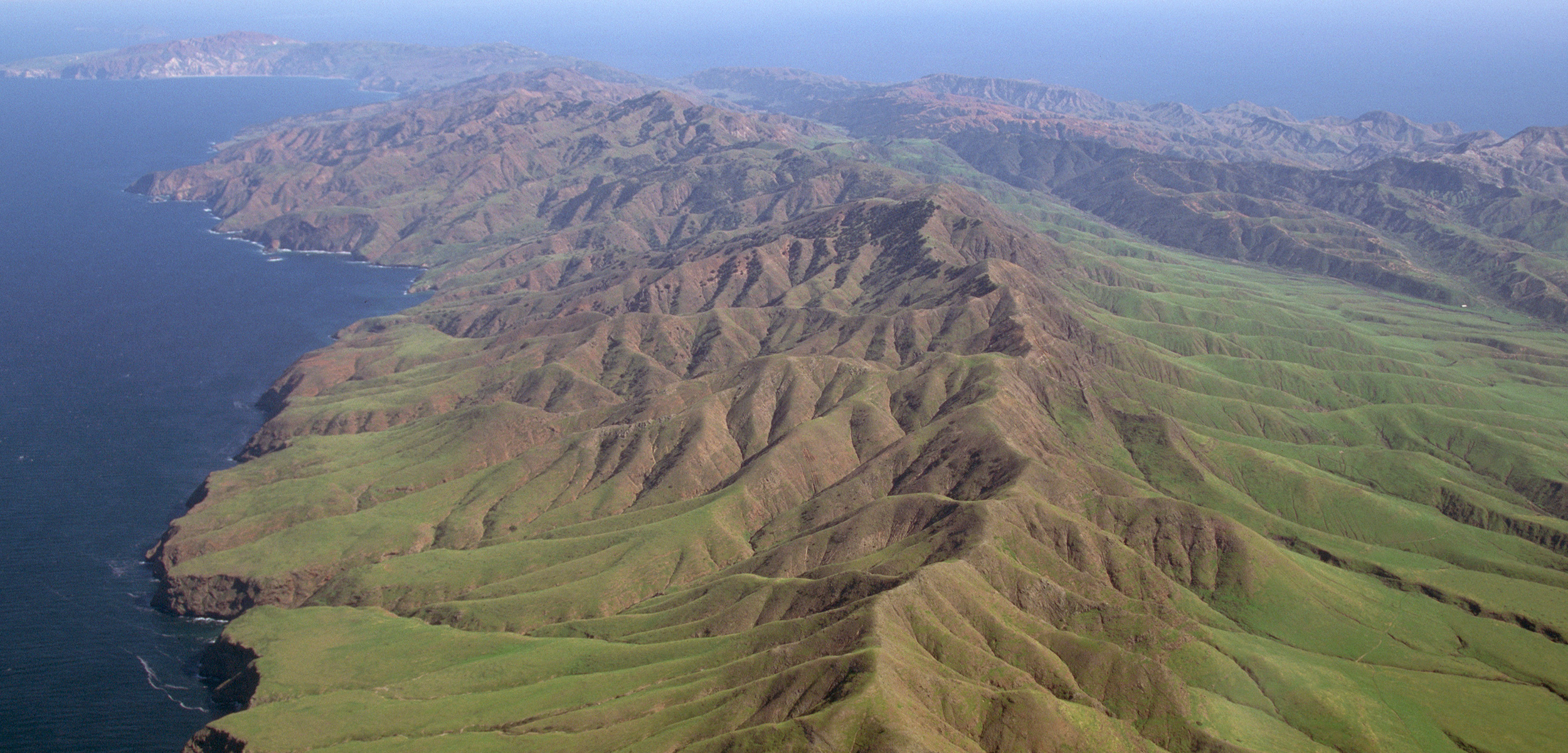Secrets of a Small Island
Before Europeans arrived, California’s Santa Cruz Island was an economic powerhouse for the Chumash people.
Article body copy
The boat rears up under an enormous jade-colored swell, and slams down in an explosion of bright spray. The cloudless California sky vanishes as foamy water smacks the windows. A collective groan sweeps through the 100 backpackers and kayakers as the vessel bucks its way across the 40 kilometers or so of ocean separating the California mainland from Santa Cruz, the largest of the eight Channel Islands scattered off the state’s southern coast. Sprawling close to 250 square kilometers, Santa Cruz is more than four times the size of Manhattan, but is now virtually uninhabited.
Jon Erlandson sits calmly in the seat across from me, unperturbed by the rough seas that make my stomach heave. A lanky 60-year-old archaeologist at the University of Oregon, he is describing the lushness of an island that fed dense populations of humans for more than 10,000 years. “There is a lot of food out there,” adds his colleague and wife, Kristina Gill, a slender 33-year-old archaeologist at the University of California at Santa Barbara, nodding toward the island looming ahead.
Out the window on this August day, a rocky cliff rises a hundred meters above the breaking surf. Beyond that is a line of jagged reddish-tinged hills. The barest hint of dark green shows in some of the mountain creases. The place looks anything but lush. “If you want to know what it was like before Europeans came, you can’t look at the modern geography,” Erlandson explains when I ask him about the discrepancy between what he and Gill say and what I see. Goats, sheep, and pigs introduced by ranchers devoured the plants during the past two centuries, turning a verdant landscape into an often-barren terrain of stone intersected by eroded gullies.
This forbidding landscape led archaeologists to regard Santa Cruz and the other Channel Islands as hostile places where humans struggled to eke out a living. Some researchers even suggested that the islanders depended on the mainland’s larger settlements and extensive trade networks for necessary resources. “The Channel Islands have a typically impoverished insular fauna and flora,” wrote one archaeologist dismissively in the 1960s, adding that the lack of fresh water also restricted population growth. That conclusion proved dead wrong.
By excavating ancient sites and analyzing carbonized seeds as well as shells and bones left by the indigenous inhabitants, Erlandson, Gill, and their team are turning that conventional wisdom on its head. They make the bold claim that the northern Channel Islands served as an economic powerhouse for millennia, producing not just plentiful food and year-round settlements, but also millions of shell beads that served as currency across southern California. “This was the mint,” Erlandson says. The people on the mainland, it turns out, badly needed the trade with the Santa Cruz inhabitants. “There are probably 4,000 [archaeological] sites on this island alone,” the archaeologist adds as the bucking boat nears its first landing.
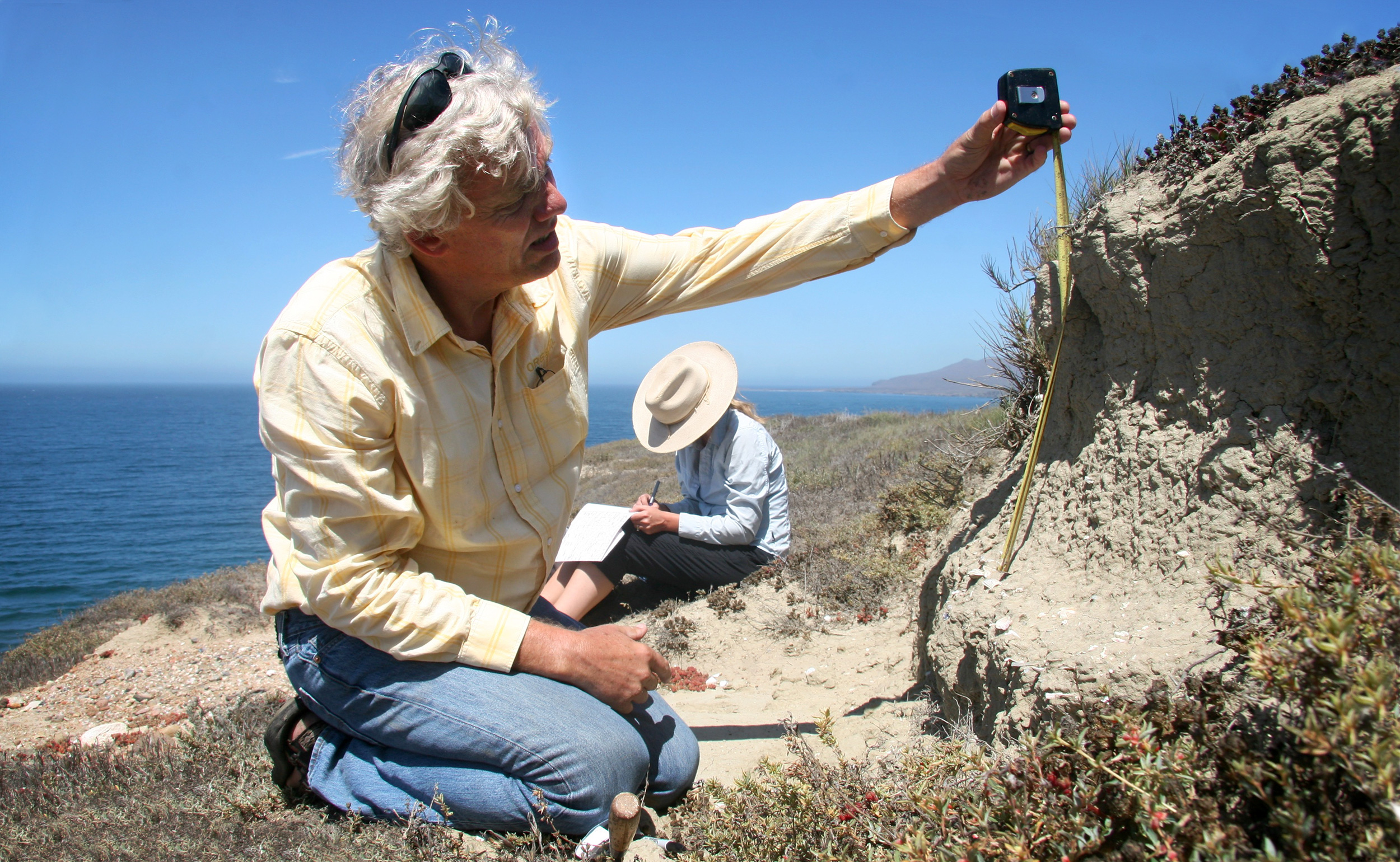
Archaeologist Jon Erlandson examines a thick midden comprised of shells and other food scraps discarded by the island’s ancient inhabitants. Photo by Mahan Kalpa Khalsa
The growing evidence that indigenous groups made their home here for so long and so successfully also is encouraging archaeologists to consider minor islands around the globe in a new light. “We need to start thinking small,” says Victor Thompson, an archaeologist at the University of Georgia who studies the emergence of complex indigenous societies in southern Florida and excavates at the island site of Mound Key.
The queasy tourists disembark at a dock on Santa Cruz’s eastern neck, part of the Channel Islands National Park, leaving only a dozen of us for the 20-minute trip to the next stop, the ominously named Prisoners Harbor on the north coast that serves as the entry point for the larger western mass of mountains and sloping hills.
When Europeans first arrived on the Channel Islands in the 16th century, they encountered an ancient maritime society, the Chumash. Superbly adapted to island life, the Chumash harvested a wide range of resources, from fish, seals, sea lions, and shellfish, to acorns and other terrestrial foods. In sturdy plank canoes known as tomols, they fished deep water and regularly crossed to the mainland. There they developed extensive trading networks that reached into northern California and the deserts of the Southwest, often using shell beads for exchange.
The first recorded encounter between the island Chumash and a Spanish expedition in the 16th century ended badly for the Spanish. The Spaniards’ leader fell, broke a limb, and died on one of the islands. And after that, Europeans were slow to colonize the area. But in 1803, a Spanish friar reported that Santa Cruz “abounds with timber, water, and soil,” and, in 1864, when the American Civil War was nearing an end, Santa Cruz was a vast ranch with 24,000 sheep worked by Italian immigrants and Chumash laborers.
When the Nature Conservancy bought most of the island in 1978, livestock had grazed the island down to its barest bones, and feral pigs had rooted up many of the native plants, such as oak seedlings. The Conservancy removed the sheep, and a SWAT team of New Zealand hunters rid the island of all its wild pigs. Today, native plants and animals are starting to recover, making Santa Cruz a kind of ecological time machine.
But the Chumash, whose ancestors helped shape the island’s ecology for more than 10 millennia, no longer live on Santa Cruz. The only people allowed on the western side of the island today are visiting scientists, students, and a small maintenance crew who roam what is a vast research park, with no paved roads, kilometers of empty beaches, and gorgeous views without a condo or hotel in sight. Erlandson and Gill let me tag along as they looked for ancient sites during a recent expedition.
A battered Land Cruiser parked at the end of the long dock soon takes us past a restored 19th century ranch, complete with brick chapel, stables, and remains of a vineyard, and up a wide valley that runs along a straight-as-an-arrow fault line, splitting the island in half. “Here we are, four years into an epic drought!” Erlandson yells as Gill hits a low gear to splash through a marshy creek. The absence of grazing animals means the return of taller vegetation and woodlands that can suck moisture from the frequent sea fogs, slowly replenishing the island’s depleted water table.
Above us rises Diablo Peak, the highest point in the Channel Islands, towering more than 740 meters over the sea. Gill halts the Land Cruiser and leads us up across a steep slope. For years now, archaeologists have known that the island-dwelling Chumash had access to plenty of seafood and birds along the shoreline. “There is lots of protein and fats here,” says Erlandson, as we walk across the dry soil baking in the August sun. “But where are the carbs?”
Humans need carbohydrates to survive: they are the preferred fuel source for our bodies. According to one popular theory, the islanders imported carb-rich acorn flour from the mainland in exchange for shell beads manufactured on the Channel Islands. But Gill, who studies ancient plant use, learned from her excavations that the indigenous islanders seldom bothered gathering or eating the local acorns or pine nuts, and she wondered why. The answer came once the feral pigs were gone. The hillsides now are covered in a short green weedy plant. Using her archaeologist’s trowel, she scrapes the hard ground and pulls up small nodules that look like little onions. “You can harvest these any time of the year,” Gill says as she scratches up a dozen or two with a few minutes effort.

With the removal of sheep and wild pigs from the island in recent years, native plant species—vital sources of nutrition for past inhabitants—are finally rebounding on Santa Cruz, says archaeologist Kristina Gill. Photo by Mahan Kalpa Khalsa
Known as the blue dick, this perennial plant possesses a corm—an underground storage organ—that is loaded with more carbs (when cooked) than acorns. The remains of carbonized blue dicks litter settlement excavations, demonstrating that they were a regular part of the Chumash diet. Gill holds out the small milky-white bulb. I nibble on a piece and it leaves an unpleasant starchy taste.
That night Gill roasts the corms in tinfoil in the campfire. When cooked, they take on a slightly sweet flavor that goes well with the surfperch that Erlandson caught from shore at a nearby beach. After a few minutes on the fire, the white fish is tender and juicy. Cactus pads—“a natural insulin regulator,” explains Gill as she burns off the thorns in the fire—are a side dish. “It is impossible to starve or go hungry here,” adds Erlandson after we eat and the stars come out by the thousands. “This is a story of coping with abundance.”
Among his Chumash friends, Erlandson is known as “the hiking Viking” for his tall frame, blond hair—now graying—and tendency to wander barefoot. In a nod to the late-summer heat and jagged rocks of Santa Cruz, he is wearing sandals. Though his pace is deceivingly leisurely when he walks, his long legs carry him across vast stretches of space in little time. “If you look down for a moment, he’s three ridges ahead of you,” says Gill.
Erlandson grew up across from Santa Cruz, in Santa Barbara, and surfed as a kid in the cold North Pacific waters. As a young archaeologist, he landed on small, sandy, and windswept San Miguel, one of the northern Channel Islands. It had long seemed an unlikely place to search for the remains of ancient humans, but archaeologists had found signs of human habitation in earlier excavations. The small island was perfect for Erlandson, who has a knack for spotting the subtle traces of a camp abandoned thousands of years ago. “Jon is an early sites magnet,” says Amy Gusick, an archaeologist at California State University in San Bernardino who collaborates with him.
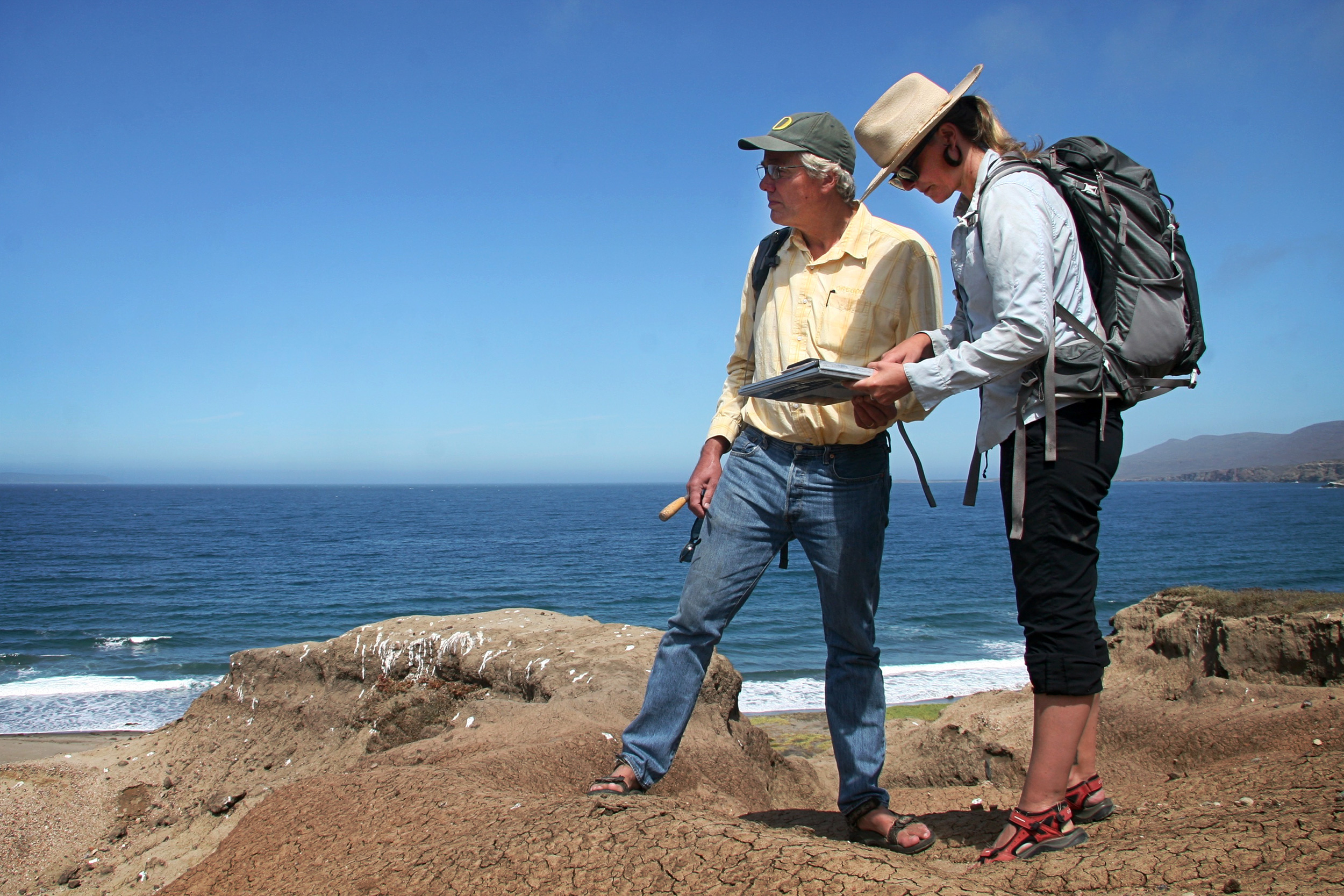
On the island of Santa Cruz, off the coast of California, archaeologists Jon Erlandson and Kristina Gill are collaborating on a project to determine why ancient people chose to live in remote parts of the island—far from shores that abounded in shellfish and other marine foods. Photo by Mahan Kalpa Khalsa
Erlandson also has a knack for upsetting paradigms. On San Miguel in the early 1990s, he started to amass proof that the island was inhabited more than 10,000 years ago—and possibly as early as 13,000 years ago—a time when sea levels were lower and all the northern Channel Islands formed a single mega-island, Santarosae. Erlandson concluded that ancient humans used Santarosae as a steppingstone in their migration down the Pacific Coast, arguing convincingly that humans in boats moved from northeastern Asia into the Americas along what he called “the kelp highway,” hunting and fishing in coastal kelp beds as they went. A host of finds on the four northern Channel Islands confirms his theory. For example, a skeleton found on Santa Rosa, just west of Santa Cruz, dates back 13,000 years, making it one of the oldest human remains ever dated in North America.
Now Erlandson, working with experts in bones, plants, and landscapes, wants to know how people lived on Santa Cruz before Europeans disrupted Chumash culture and laid waste to the environment. On this week’s expedition, Erlandson and Gill are gathering samples for dating prehistoric sites on the island’s western half. “We’ve recorded about 150 new sites,” Erlandson says the next morning, slipping his trowel inside his backpack. “And we’ve visited scores of others that already were surveyed.”
One afternoon during my stay we trek across treacherous gullies to a long sandy beach on the south coast, which is completely empty on a sunny Saturday. After peanut-butter-and-jelly sandwiches, Erlandson leads us up into a deep and undulating erosion channel twice his height and barely wide enough for us to squeeze through in single file.
The channel cuts through part of an ancient indigenous settlement that measures 900 square meters, about a tenth of a city block, and dates back 8,700 years. “We are a kilometer from the shore of 9,000 years ago,” Erlandson says, peering out to sea, “yet still people were living here on a continuous basis.”
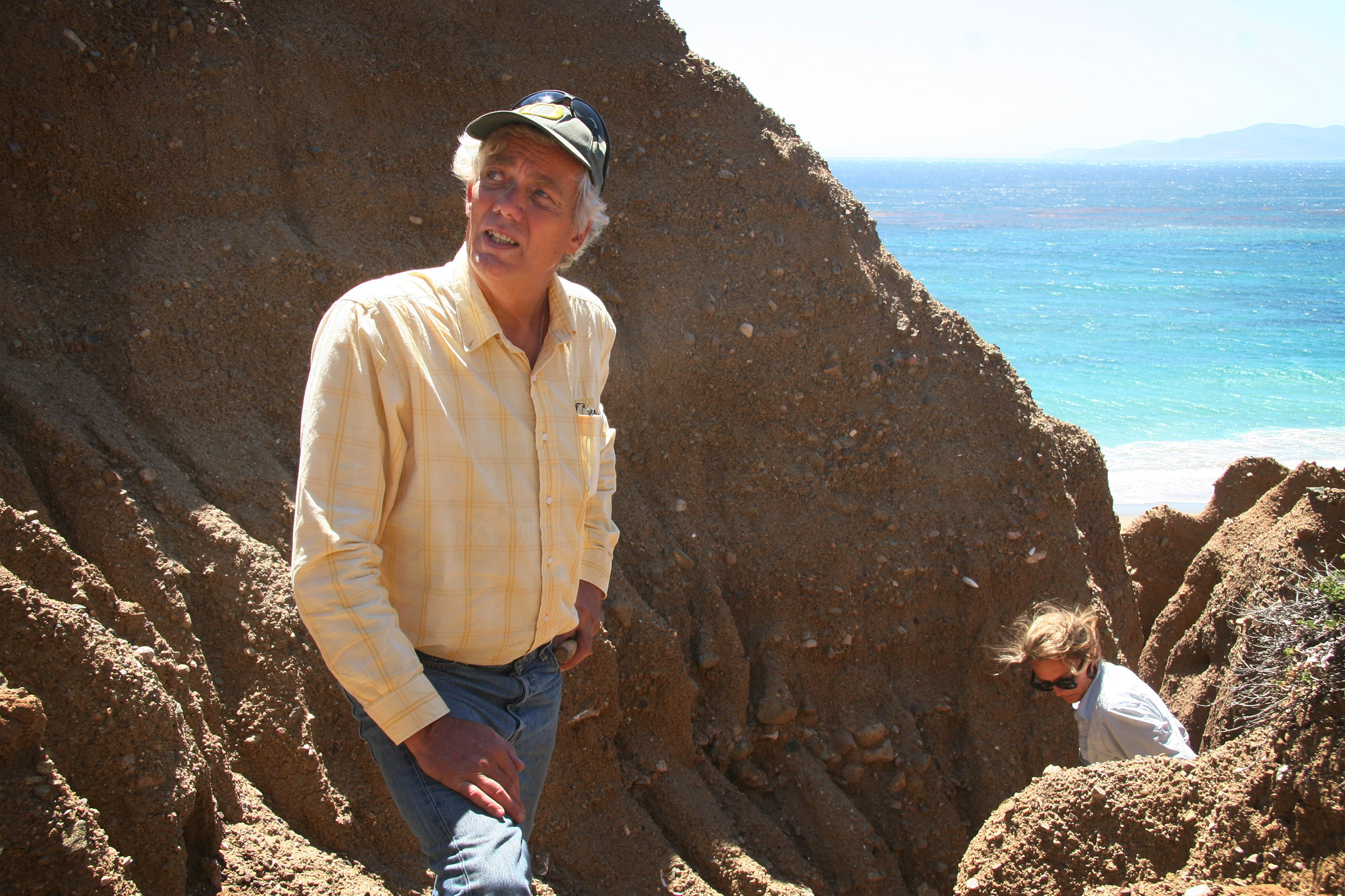
It may appear bleak and forbidding today, but the island of Santa Cruz was rich in food resources before the arrival of Europeans, says archaeologist Jon Erlandson. Photo by Mahan Kalpa Khalsa
One of the puzzles the couple is trying to solve is why people chose to live in remote spots on the island—far from the shore, high in the hills, or on the island’s exposed north side, which is lined with high cliffs that make the sea difficult to reach. Old aerial photographs show that shell middens, the remains of islanders’ ancient clambakes, are scattered across the entire island. These heaps of discarded shells show up on aerial images as pale rings around darker earth.
On another day, we drive up into the hills on a rutted track so vertical that I have to hold tightly to the Land Cruiser’s roll bar to avoid tumbling out the back. At the top of the ridge, on the island’s northwest end, a fierce and welcome blast of cool sea air sweeps into our faces.
The view to Santa Barbara and the coastal mountains is spectacular. Sliding out of the vehicle, we hike to the edge of a cliff, where a thick shell midden reveals the long-term presence of humans. The site, one of the oldest known on the island, dates to 9,800 years ago. “The question is why,” says Gill, raising her voice to be heard over the howl. “Why come over here? We were totally surprised when we started surveying on this side of the island and found settlements.”
The next morning, as a fog bank lingers offshore, Gill takes me to an even more improbable village site on the north side of the island while Erlandson goes prospecting for new sites and interesting geology. It’s a grueling hike up and across the side of Mount Diablo and then down old sheep paths to a site Gill calls Diablo Valdez, which provided much of the data for her PhD dissertation. Aside from a few rare copses of live oaks, there’s no shade en route, and the ocean glitters far below the rocky slopes. We arrive sweat soaked, and a film of dust covers the tattooed hummingbird on Gill’s arm.
Gill met Erlandson while she was working on the island as a graduate student, and their joint fascination with the Channel Islands’ prehistory and their complimentary skills led to a personal and professional collaboration. Over the course of my visit, Erlandson looks for previously overlooked middens and stone tools, while Gill stops mainly to examine plants, such as the lemonadeberry, which tastes remarkably like lemon candy, and the mariposa lily.
The Chumash clearly knew the island’s plants and what they could be used for. “People were managing plant resources here—milkweed, tobacco, datura,” Gill adds. Chumash shamans gathered datura, for example, for their rituals: it produces a powerful mind-altering substance said to erase the line between fantasy and reality.
Gill began her excavations at the Diablo Valdez settlement in 2011, one of the first inland sites to be dug on the island, and the most substantial. “It’s not an easy place to work,” she concedes. Over the course of a summer, she and her team hiked in and out every day, carrying packs jammed full of necessary supplies and equipment. When the field season wrapped up, she obtained helicopter support to fly a tonne of soil samples from Diablo Valdez to the road for transport by car and boat back to her Santa Barbara lab.
As she analyzed the finds, Gill was astonished to discover that people lived at Diablo Valdez nearly continuously, for almost 6,000 years. “The continuity is breathtaking,” she says, adding that the inhabitants’ diets remained very much the same over that entire period of time. The dig revealed Chumash houses, roasting pits, and mortars cut into the rock. “This was not a seasonal camp,” Gill explains. The inhabitants “ate plants harvested in spring, summer, fall, and winter.”
Gill suspects the people in the uplands had more access to the firewood necessary for cooking, and they may have traded this fuel for seafood from settlements along the shoreline. Also, fresh water may have been more plentiful in hillside springs such as one that flows next to Diablo Valdez.
On the way back, we pick up Erlandson as he ambles along the dusty road, about 10 kilometers from where we dropped him off just a few hours earlier. As we pass through a small valley, Gill points out yet another ancient settlement. Here—as at many sites—archaeologists uncovered large numbers of shell beads that were broken or unfinished. It was just one of the small “mints” on an island that produced millions of beads for exchange.
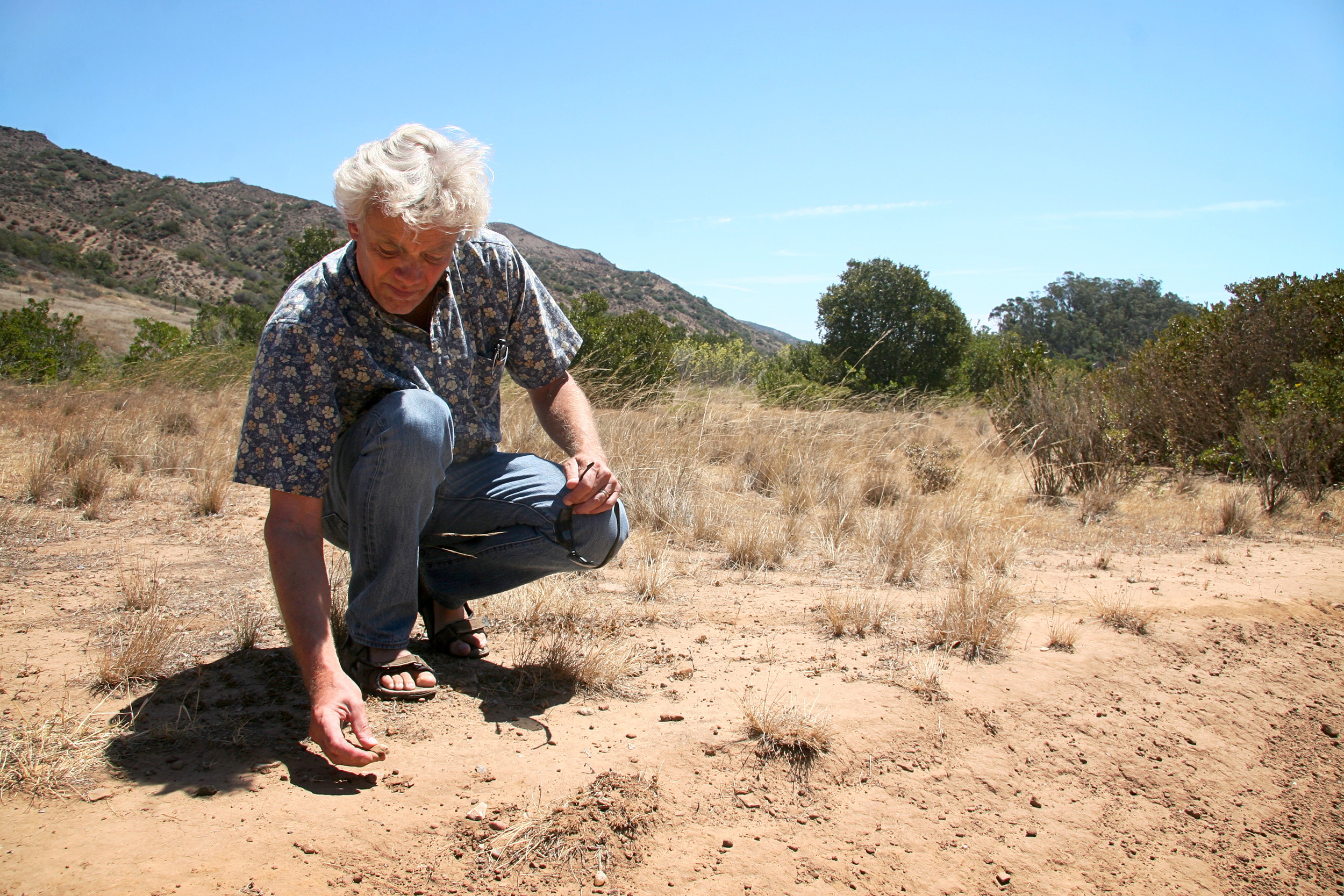
Dubbed the Hiking Viking by his Chumash friends, archaeologist Jon Erlandson searches for traces of campsites on Santa Cruz that were abandoned thousands of years ago. Photo by Mahan Kalpa Khalsa
The concept of using a material like shell for money in prehistoric North America was not unique to the Chumash. Along the Pacific Northwest coast, for example, indigenous groups sometimes used gleaming tooth-shaped dentalium shells as a kind of currency and in northern California, the Pomo people favored beads made of clamshells. But the sheer numbers of Chumash shell beads and their broad geographic range has astonished many archaeologists.
“The shell beads took many, many forms and changed through time,” Erlandson says. The most common were made from the shells of purple olive snails (Callianyx biplicata or Olivella biplicata), and the beads came in a variety of shapes, from whole shells to small disks. In later times, between 1300 and 1780 CE, the Chumash often made this currency from the thick portion of the shell called the callus, which yielded only one bead per shell. And yet millions of these shell beads were manufactured at sites around the island, most for export to the mainland.
After lunch in the shade at the restored ranch, the two scientists drop me off at Prisoners Harbor for the ride back to the mainland. The water has calmed and the California coast hovers in the distance. The work by Erlandson and Gill and other researchers on Santa Cruz has implications that go far beyond the Channel Islands. It also is inspiring a new generation of researchers to look more closely at small islands that have long been considered marginal and uninteresting. “What the world needs now is more island archaeologists,” says Scott Fitzpatrick, one of Erlandson’s young colleagues at the University of Oregon.
Long ignored and dismissed, Santa Cruz is finally making archaeologists sit up and take notice of the richness and bounty that long drew humans to the shores of small islands around the world.

